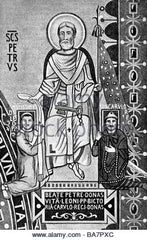Discourses on Solemn Mass: Part V
This series was written for Angelus Press by Louis Tofari
Discourses on Solemn Mass: Part V
 After the sacred ministers have attired themselves in their amices, albs and cinctures, the maniple is next put on the left forearm. The maniple is formed from a single piece folded over the forearm which hangs about 14 inches on either side. The outward facing sides of the maniple are usually stitched (or pinned) – this feature is especially important for the celebrant, as it prevents them from creeping up over the altar, especially the corporal after the Consecration. The maniple is adorned with a cross in the center which is kissed by the sacred ministers before placing it on their left forearms. The maniple is then secured to the forearm, either with ties (or in these modern days, an elastic band) attached to the underside or even with a pin inserted through the top of the maniple into the alb.
After the sacred ministers have attired themselves in their amices, albs and cinctures, the maniple is next put on the left forearm. The maniple is formed from a single piece folded over the forearm which hangs about 14 inches on either side. The outward facing sides of the maniple are usually stitched (or pinned) – this feature is especially important for the celebrant, as it prevents them from creeping up over the altar, especially the corporal after the Consecration. The maniple is adorned with a cross in the center which is kissed by the sacred ministers before placing it on their left forearms. The maniple is then secured to the forearm, either with ties (or in these modern days, an elastic band) attached to the underside or even with a pin inserted through the top of the maniple into the alb.
The name “maniple” is derived from the Latin word “manus” or hand, and originally was a handkerchief (or cloth napkin), tucked into or pinned to the sleeve’s hem as the historical fad dictated. This is the origin of the maniple’s spiritual representation of tears (i.e., sweat droplets) from the fatigue of working in the Lord’s vineyard. As another historical note, in some places the celebrant’s maniple (or even the second one worn) was a long narrow band of linen which was actually used for wiping out the chalice as is done with today’s purificator.
There are two interesting rubrical mentions concerning the maniple. First, some rubricians direct the deacon and subdeacon to delay putting on the maniple until the celebrant has put on his maniple, or more precisely, after they have put on respectively the last of their outer vestments. The reason is so they can more easily assist the celebrant to vest, though this is not always strictly required or observed. Secondly, if the cleric fulfilling the office of subdeacon has not been ordained at least to the subdiaconate (e.g. having only clerical tonsure or minor holy orders), he is not allowed to wear the maniple. So though the maniple is often considered as insignificant amongst the other vestments, in fact it represents something “superior” – i.e., the first step in major holy orders.
 Next is the stole, whose name is derived from the Greek word “stola” meaning merely a “garment” or perhaps more appropriately “array” (referring to adorn or embellish one’s dress). Indeed this vestment piece – particularly how it is worn – signifies as a type of badge (or adornment) the rank of its wearer, being reserved to either the deacon or celebrant. Thus, it may not be worn by those whose have not been ordained at least to the diaconate, though originally, it was worn by all ministers, including the acolytes, though in a different ways.[1]
Next is the stole, whose name is derived from the Greek word “stola” meaning merely a “garment” or perhaps more appropriately “array” (referring to adorn or embellish one’s dress). Indeed this vestment piece – particularly how it is worn – signifies as a type of badge (or adornment) the rank of its wearer, being reserved to either the deacon or celebrant. Thus, it may not be worn by those whose have not been ordained at least to the diaconate, though originally, it was worn by all ministers, including the acolytes, though in a different ways.[1]
Unfortunately, the developmental history of the stole is rather murky prior to the 9th century, though it seems it may have originally had the same role as the amice, acting as a kind of neckerchief, and gradually lengthening in size. Another common explanation is that it evolved from the scarves of honor worn by Roman authorities in the later years of the Empire. What we do know – as shown by ample ancient depictions – is that the stole was originally worn over the outer vestments, like a loose scarf around the neck, with one end hanging down the back and the other down the front – just like today’s woolen pallium, itself derived from the older manner of wearing the stole. In fact, the earlier practice of wearing the stole over the outer vestments is still done in some Eastern Rites by prelates and deacons.
The explanation of the stole will continue with the next discourse.
Leave a comment
Comments will be approved before showing up.
Also in Angelus Press Blog

2025 Angelus Press Conference Live Stream
For those of you who will not be able to attend the Angelus Press Conference for Catholic Tradition in person we are now offering easy access to the live-streaming service.

Angelus Press Website Update is Complete


Angelus Press
Author